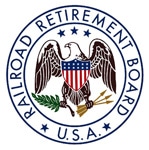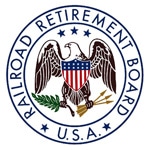The amounts of compensation subject to Railroad Retirement Tier I and Tier II payroll taxes will increase in 2020, while the tax rates on employers and employees will stay the same. In addition, unemployment insurance contribution rates paid by railroad employers will not include a surcharge for the first time in five years.
Tier I and Medicare Tax — The Railroad Retirement Tier I payroll tax rate on covered rail employers and employees for 2020 remains at 7.65 percent. The Railroad Retirement Tier I tax rate is the same as the Social Security tax, and for withholding and reporting purposes is divided into 6.20 percent for retirement and 1.45 percent for Medicare hospital insurance. The maximum amount of an employee’s earnings subject to the 6.20 percent rate increases from $132,900 to $137,700 in 2020, with no maximum on earnings subject to the 1.45 percent Medicare rate.
An additional Medicare payroll tax of 0.9 percent applies to an individual’s income exceeding $200,000, or $250,000 for a married couple filing a joint tax return. While employers will begin withholding the additional Medicare tax as soon as an individual’s wages exceed the $200,000 threshold, the final amount owed or refunded will be calculated as part of the individual’s Federal income tax return.
Tier II Tax — The Railroad Retirement Tier II tax rates in 2020 will remain at 4.9 percent for employees and 13.1 percent for employers. The maximum amount of earnings subject to Railroad Retirement Tier II taxes in 2020 will increase from $98,700 to $102,300. Tier II tax rates are based on an average account benefits ratio reflecting Railroad Retirement fund levels. Depending on this ratio, the Tier II tax rate for employees can be between 0 percent and 4.9 percent, while the Tier II rate for employers can range between 8.2 percent and 22.1 percent.
Unemployment Insurance Contributions — Employers, but not employees, pay railroad unemployment insurance contributions, which are experience-rated by employer. The Railroad Unemployment Insurance Act also provides for a surcharge in the event the Railroad Unemployment Insurance Account balance falls below an indexed threshold amount. The accrual balance of the Railroad Unemployment Insurance Account was $157.5 million on June 30, 2019. Since the balance was more than the indexed threshold of $152.3 million, there will not be a surcharge added to the basic contribution rates for 2020. Previously, the rates have included a 1.5 percent surcharge every year since 2015.
As a result, the unemployment insurance contribution rates on railroad employers in 2020 will range from the minimum rate of 0.65 percent to the maximum of 12 percent on monthly compensation up to $1,655, an increase from $1,605 in 2019.
In 2020, the minimum rate of 0.65 percent will apply to about 84 percent of covered employers, with almost 5 percent paying the maximum rate of 12 percent. New employers will pay an unemployment insurance contribution rate of 3.10 percent, which represents the average rate paid by all employers in the period 2016-2018.
Tag: tax rates

Tier I and Medicare Tax.–The railroad retirement tier I payroll tax rate on covered rail employers and employees for 2017 remains at 7.65 percent. The railroad retirement tier I tax rate is the same as the social security tax, and for withholding and reporting purposes is divided into 6.20 percent for retirement and 1.45 percent for Medicare hospital insurance. The maximum amount of an employee’s earnings subject to the 6.20 percent rate increases from $118,500 to $127,200 in 2017, with no maximum on earnings subject to the 1.45 percent Medicare rate.
An additional Medicare payroll tax of 0.9 percent applies to an individual’s income exceeding $200,000, or $250,000 for a married couple filing a joint tax return. While employers will begin withholding the additional Medicare tax as soon as an individual’s wages exceed the $200,000 threshold, the final amount owed or refunded will be calculated as part of the individual’s Federal income tax return.
Tier II Tax.–The railroad retirement tier II tax rates in 2017 will remain at 4.9 percent for employees and 13.1 percent for employers. The maximum amount of earnings subject to railroad retirement tier II taxes in 2017 will increase to $94,500 from $88,200. Since 2004, tier II tax rates are based on an average account benefits ratio reflecting railroad retirement fund levels. Depending on this ratio, the tier II tax rate for employees can be between 0 percent and 4.9 percent, while the tier II rate for employers can range between 8.2 percent and 22.1 percent.
Unemployment Insurance Contributions.–Employers, but not employees, pay railroad unemployment insurance contributions, which are experience-rated by employer. The Railroad Unemployment Insurance Act also provides for a surcharge in the event the Railroad Unemployment Insurance Account balance falls below an indexed threshold amount. The accrual balance of the Railroad Unemployment Insurance Account was $93.8 million on June 30, 2016. Since the balance is less than the indexed threshold of $152.9 million, a 1.5 percent surcharge will be added to the basic contribution rates for 2017, but will not increase the maximum 12 percent rate. There was also a surcharge of 1.5 percent in 2015 and 2016, with no surcharge in 2013 and 2014.
As a result, the unemployment insurance contribution rates (including the 1.5 percent surcharge) on railroad employers in 2017 will range from the minimum rate of 2.15 percent to the maximum of 12 percent on monthly compensation up to $1,545, up from $1,455 in 2016.
In 2017, the minimum rate of 2.15 percent will apply to 78 percent of covered employers, with 8 percent paying the maximum rate of 12 percent. New employers will pay an unemployment insurance contribution rate of 1.62 percent, which represents the average rate paid by all employers in the period 2013-2015.

The Tier II tax rates are determined annually from a tax rate schedule based on an average account benefits ratio reflecting railroad retirement fund levels. Employer tax rates can range from 8.2 percent to 22.1 percent. Employee tax rates can range from 0 percent to 4.9 percent.
Experience Rating
In October 2015, each employer was sent a notice of their 2015 Railroad Unemployment Insurance Act (RUIA) contribution rate. If you have not received your notice, please contact the Quality Reporting Service Center.
Retirement and Survivor Benefits
Exempt Amounts for Annual Earnings Test for Less Than Full Retirement Age Annuitants: In 2016, the annual exempt amount for less than full retirement age annuitants is $15,720. The monthly exempt amount for the first year of retirement in 2016 is $1,310.
Exempt Amounts for Annual Earnings Test for Full Retirement Age Annuitants: In 2016, the annual exempt amount for full retirement age annuitants is $41,880. The monthly exempt amount for the first year of retirement in 2016 is $3,490.
No cost-of-living Increase: Annuitants will not receive a cost-of-living increase in 2016.
Unemployment and Sickness Benefits
Maximum Daily Benefit Rate: Under the Railroad Unemployment Insurance Act (RUIA), the maximum daily benefit rate is equal to 5 percent of the monthly RUIA compensation base, rounded down to the nearest multiple of $1.00. For days of unemployment and sickness in registration periods beginning on and after July 1, 2016, the maximum daily rate is $72.00. The maximum rate for registration periods beginning on or after July 1, 2017, is $72.00.
Monthly Compensation Base: The monthly compensation base under the Railroad Unemployment Insurance Act for calendar year 2016 is $1,455.
Qualifying Base Year Compensation: The amount of base year compensation required in 2016 to qualify for benefits in the benefit year beginning July 1, 2016, is $3,637.50.
Compensation of $3,637.50 is also the amount of creditable compensation required to end a voluntary leaving of work disqualification period in months in calendar year 2016. In addition, remuneration earned in calendar year 2016 from employment covered under the Act cannot be considered subsidiary remuneration if the employee’s base year earnings are less than $3,673.50.
Maximum Benefits: The monthly amount of base year 2016 compensation that can be counted in determining the maximum amount of normal benefits payable to an employee in the benefit year beginning July 1, 2017, is $1,879.
Maximum Monthly Compensation Base and the Earnings Test: For unemployment registration periods beginning July 1, 2017 and later, no benefits are payable for which the total amount of an employee’s earnings and other remuneration from railroad and non-railroad work for days in the period exceeds the monthly compensation amount of $1,455.
The 2016 railroad retirement tax rates and maximum compensation bases are as follows:
| Tax Type | Tax Rate | Earnings Base |
| Employee Medicare* | 1.45% | No limit |
| Employer Medicare* | 1.45% | No limit |
| Employee Tier I | 6.20% | $118,500 |
| Employer Tier I | 6.20% | $118,500 |
| Employee Tier II | 4.90% | $88,200 |
| Employer Tier II | 13.10% | $88,200 |
*Additional Medicare Tax: Employees will pay an additional 0.9 percent Medicare tax on earnings above $200,000 who file an individual return or $250,000 (for those who file a joint return). This additional Medicare tax rate is not reflected in the tax rates shown above.
Note: Medicare and Tier 1 Railroad Retirement tax rates are equivalent to Social Security tax rates set for 2016. Tier 2 Railroad Retirement tax rates do not apply to employees subject to Social Security.
The Railroad Retirement Board reports it has adjusted benefits — effective with February benefits checks — for more than 140,000 beneficiaries to reflect new federal income tax withholding rates.
The new rates comply with provisions of the congressionally passed Tax Relief, Unemployment Insurance Reauthorization and Job Creation Act of 2010.
The new rates apply to withholding from the non-Social Security equivalent portion of Tier I, Tier II, vested dual benefits, and supplemental annuity payments, and will remain in use for the remainder of 2011.
The Railroad Retirement Board says that in the absence of a request not to withhold federal income tax or to withhold the tax at specific amounts, the board will withhold taxes only if the combined portions of the non-Social Security equivalent portion of Tier I, Tier II, vested dual benefit, and supplemental annuity payments are equal to or greater than an annual threshold amount.
In that case, the RRB withholds taxes as if the annuitant were married and claiming three allowances.
The annual threshold amount for 2011 is $1,587.99. The threshold amount for 2010 was $2,063.51.
Annuitants can use form RRB W-4P (Withholding Certificate for Railroad Retirement Payments) to request:
- No federal taxes be withheld from their Railroad Retirement payments
- Federal taxes be withheld based on the marital status and the number of allowances they wish to claim
- An additional amount be withheld from Railroad Retirement payments
Form RRB W-4P may be downloaded at www.rrb.gov by clicking on “Benefit Forms and Publications,” and then clicking on “Income Tax.”
Annuitants who have questions regarding their tax liability should contact the nearest office of the IRS or visit www.irs.gov.
Railroad Retirement, Social Security, Medicare and Railroad Unemployment Insurance payroll taxes have changed for 2011.
Following are the tax rates:
Railroad Retirement Tier I:
- Paid by employer: 6.20% on wages up to $106,800.
- Paid by employee: 4.2% on wages up to $106,800.
Social Security (non-railroad employment):
- Paid by employer: 6.2% on wages up to $106,800.
- Paid by employee: 4.2% on wages up to $106,800.
Medicare (railroad and non-railroad employment):
- Paid by employer: 1.45% on all wages (no cap).
- Paid by employee: 1.45% on all wages (no cap).
Railroad Retirement Tier II
- Paid by employer: 12.1% on wages up to a $79,200.
- Paid by employee: 3.9% on wages up to $79,200.
Railroad Unemployment Insurance:
- Paid by employer: 3.15% on wages up to $15,960.
- No tax on employee.